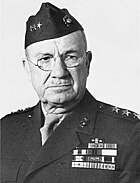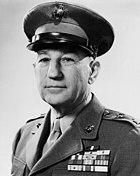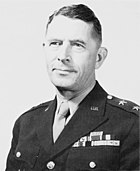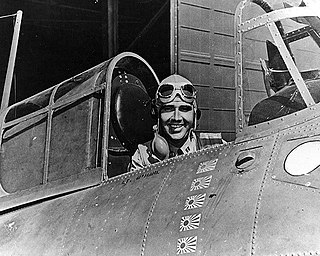
Lieutenant Commander Edward Henry O'Hare was an American naval aviator of the United States Navy, who on February 20, 1942, became the Navy's first fighter ace of the war when he single-handedly attacked a formation of nine medium bombers approaching his aircraft carrier. Even though he had a limited amount of ammunition, he was credited with shooting down five enemy bombers and became the first naval aviator recipient of the Medal of Honor in World War II.

USS Saratoga (CV-3) was a Lexington-class aircraft carrier built for the United States Navy during the 1920s. Originally designed as a battlecruiser, she was converted into one of the Navy's first aircraft carriers during construction to comply with the Washington Naval Treaty of 1922. The ship entered service in 1928 and was assigned to the Pacific Fleet for her entire career. Saratoga and her sister ship, Lexington, were used to develop and refine carrier tactics in a series of annual exercises before World War II. On more than one occasion these exercises included successful surprise attacks on Pearl Harbor, Hawaii. She was one of three prewar US fleet aircraft carriers, along with Enterprise and Ranger, to serve throughout World War II.

USS Wasp (CV-7) was a United States Navy aircraft carrier commissioned in 1940 and lost in action in 1942. She was the eighth ship named USS Wasp, and the sole ship of a class built to use up the remaining tonnage allowed to the U.S. for aircraft carriers under the treaties of the time. As a reduced-size version of the Yorktown-class aircraft carrier hull, Wasp was more vulnerable than other United States aircraft carriers available at the opening of hostilities. Wasp was initially employed in the Atlantic campaign, where Axis naval forces were perceived as less capable of inflicting decisive damage. After supporting the occupation of Iceland in 1941, Wasp joined the British Home Fleet in April 1942 and twice ferried British fighter aircraft to Malta.

The Battle of the Santa Cruz Islands, fought during 25–27 October 1942, sometimes referred to as the Battle of Santa Cruz or Third Battle of Solomon Sea, in Japan as the Battle of the South Pacific, was the fourth aircraft carrier battle of the Pacific campaign of World War II. It was also the fourth major naval engagement fought between the United States Navy and the Imperial Japanese Navy during the lengthy and strategically important Guadalcanal campaign. As in the battles of the Coral Sea, Midway, and the Eastern Solomons, the ships of the two adversaries were rarely in sight or gun range of each other. Instead, almost all attacks by both sides were mounted by carrier- or land-based aircraft.

This is the order of battle for the Battle of Midway, a major engagement of the Pacific Theatre of World War II, fought 4–7 June 1942 by naval and air forces of Imperial Japan and the United States in the waters around Midway Atoll in the far northwestern Hawaiian Islands.

The Battle of the Coral Sea, a major engagement of the Pacific Theatre of World War II, was fought 4–8 May 1942 in the waters east of New Guinea and south of the Bismarck Islands between elements of the Imperial Japanese Navy and Allied naval and air forces from the United States (U.S.) and Australia.

Operation Cockpit was an Allied attack against the Japanese-held island of Sabang on 19 April 1944. It was conducted by aircraft flying from British and American aircraft carriers and targeted Japanese shipping and airfields. A small number of Japanese ships and aircraft were destroyed, and one American aircraft was lost. While the attack was successful tactically, it failed to divert Japanese forces from other areas as had been hoped.

Kinugasa (衣笠) was the second vessel in the two-vessel Aoba class of heavy cruisers in the Imperial Japanese Navy. The ship was named after Mount Kinugasa, located in Yokosuka, Kanagawa, Japan.

Katori (香取) was the lead ship of the Katori class of three light cruisers which served with the Imperial Japanese Navy during World War II. The ship was named after the noted Shinto Katori Shrine in Chiba prefecture, Japan.
Axis & Allies Naval Miniatures: War At Sea is a standalone miniature wargame, originally produced by Avalon Hill, later by Wizards of the Coast. Axis and Allies Naval Miniatures gameplay is associated with Axis & Allies Miniatures, a World War 2 land battles game also made by Avalon Hill, but the two games are very different. Players take command of miniatures that are 1/1800 scale and represent fleets of individual warships, submarines, and squadrons of Aircraft.

Operation Tungsten was a Second World War air raid conducted by the Royal Navy that targeted the German battleship Tirpitz at her base in Kaafjord in the far north of Norway on 3 April 1944.

The Battle of Leyte Gulf, generally considered to be the largest naval combat in history, was fought 24–25 October 1944 in the waters of the Philippine Islands by elements of the Imperial Japanese Navy's Combined Fleet and the United States Navy's Pacific Fleet. Of the five separate engagements that made up the battle as a whole, the forces involved in the three principal ones are listed here.

The Battle of the Philippine Sea was fought 19–20 June 1944 in the waters west of the Mariana Islands by elements of the Imperial Japanese Navy's Combined Fleet and of the United States Navy's Pacific Fleet. The battle resulted from the Japanese reaction to the American invasion of the island of Saipan. Instead of attacking the troop transports off Saipan, Admiral Toyoda chose to engage the American carrier forces in what he intended to be the long-awaited “decisive battle” that would crush U.S. naval power.

For the April 1945 invasion of Okinawa, the Allies assembled the most powerful naval force in history. Since the few remaining capital ships of the Imperial Japanese Combined Fleet had been sunk or otherwise put out of action at the Battle of Leyte Gulf, the Allies were effectively unopposed in terms of major surface vessels; a single mission consisting of the superbattleship Yamato and a few escorts was undertaken, but the task force did not get within 200 nautical miles of the invasion area. The main Japanese naval opposition within the invasion area came from hundreds of Imperial Japanese Navy Shin'yō-class suicide motorboats and Maru-Ni Imperial Japanese Army attack boats.

On 7 August 1942, US and Australian naval forces undertook the invasion of the Japanese-held islands of Guadalcanal and Tulagi in the lower Solomon Islands chain, the first Allied offensive in the Pacific Theatre. The landing of the US 1st Marine Division on the beaches of Savo Sound began the unexpectedly long and extremely arduous Guadalcanal Campaign, lasting officially until 9 February 1943.

The Battle of the Eastern Solomons was fought August 23–25, 1942 in the waters east and northeast of the Solomon Islands by forces of the Imperial Japanese Navy's Combined Fleet and the US Navy's Pacific Fleet. The battle resulted from a major effort by the Japanese to reinforce their troop strength on the island of Guadalcanal. The Japanese high command had realized this reinforcement was necessary following the annihilation of the Ichiki Detachment by the 1st Marines a few days earlier.

The Battle of the Santa Cruz Islands was fought 25–27 October 1942 in the waters northwest of the Santa Cruz Islands by forces of the Imperial Japanese Navy's (IJN) Combined Fleet and the United States Navy's (USN) Pacific Fleet. The battle resulted from a major Japanese offensive with the goal to drive the US forces from Guadalcanal.

On 17 October 1944, troops of the United States Sixth Army under the direct command of Lieutenant General Walter Krueger, invaded the Philippine island of Leyte. This operation was the beginning of General Douglas MacArthur's fulfillment of his promise in March 1942 to the Filipino people that he would liberate them from Japanese rule.

On 15 June 1944, United States Marine and Army forces landed on the southwest coast of the island of Saipan in the central Marianas chain. US forces declared Saipan secure on 9 July.
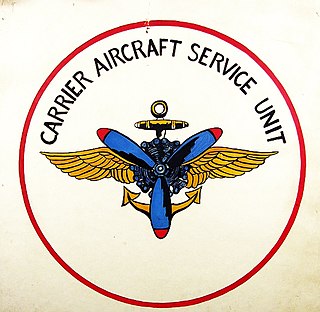
Carrier Aircraft Service Units (CASU) were United States Navy units formed during World War II for the Pacific War to support naval aircraft operations. From 1942 to 1946, 69 Carrier Aircraft Service Units were formed to repair and maintain aircraft. The first unit was deployed to Naval Station Pearl Harbor. The CASU-11, was deployed on January 22, 1943 at Naval Air Station San Diego. During the war the Navy lacked enough aircraft carriers to complete all the operational requirements.




